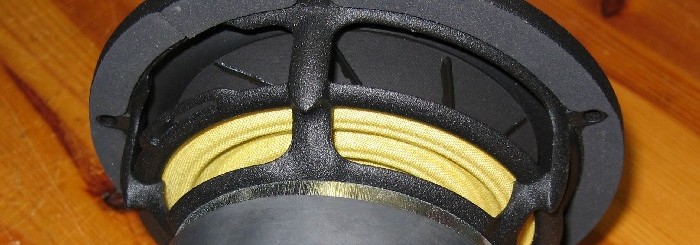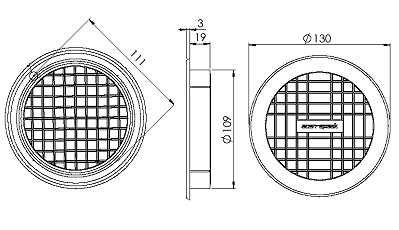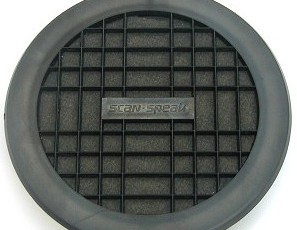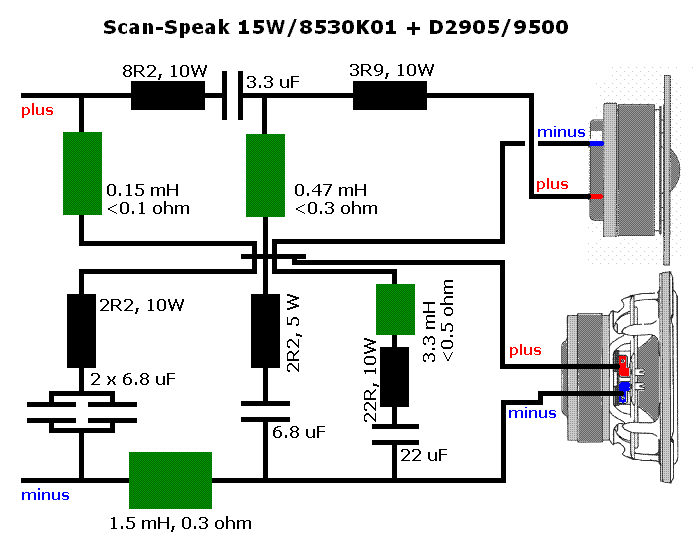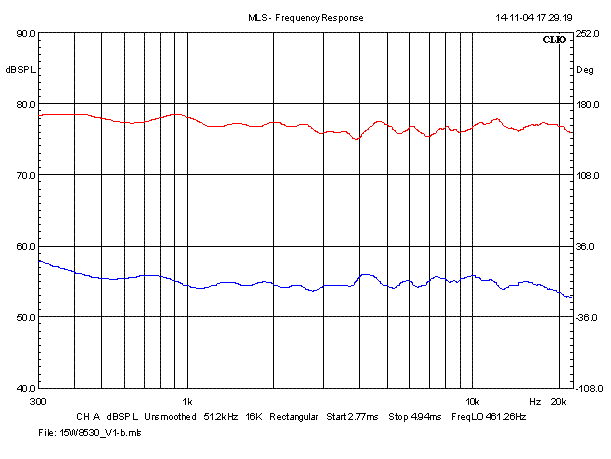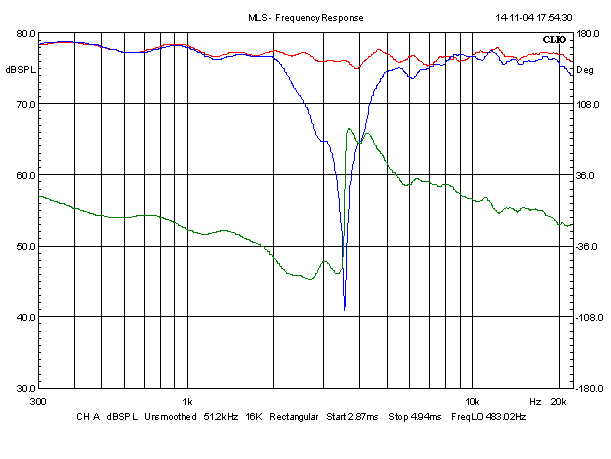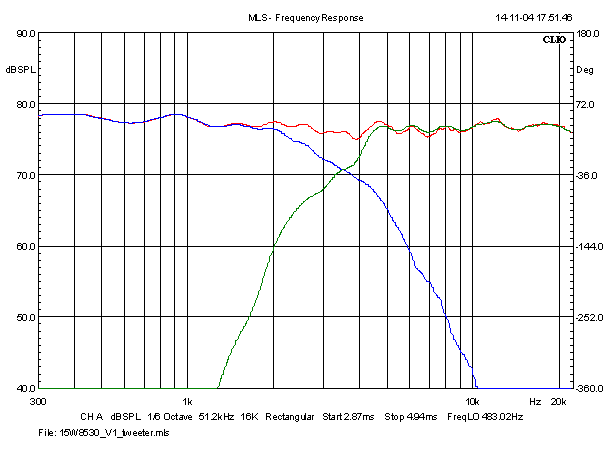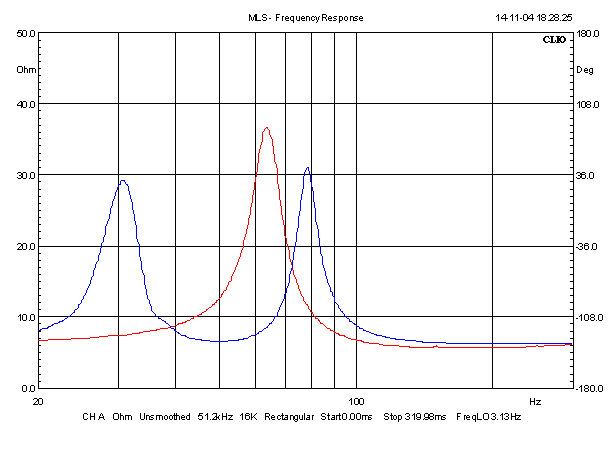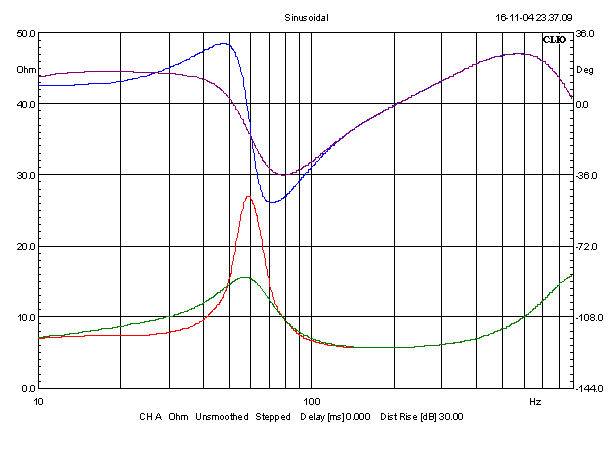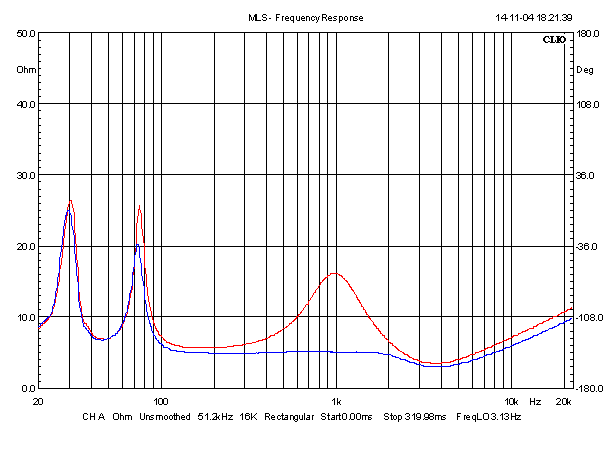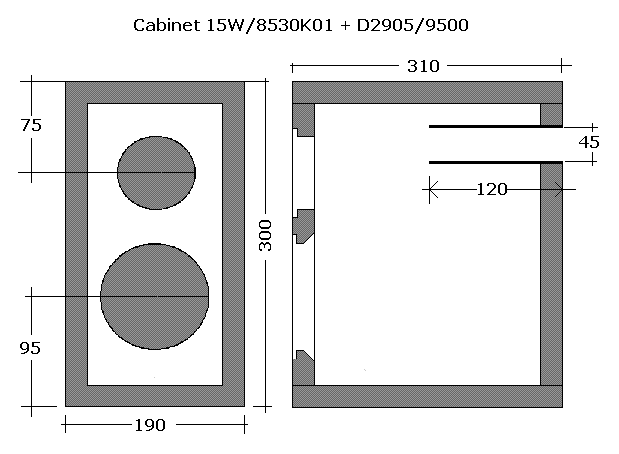| ScanSpeak 15W/8530-K01
+ D2905/9500 w/ Variovent Copyright 2005 © Troels Gravesen |
CROSS- OVER |
CABINET | MEASURE- MENTS |
BUILDER'S RESPONSE |
|
||||
| This page describes
a 10.5 litre monitor with exceptional bass extension. The
15W/8530K01 is one of the two 15W brothers with a coated
sliced paper cone and with the smallest magnet. Few notes
will follow this construction. It was made on request but
I found it so good that I will include it here on my
website. The construction is straight forward and it can
be used in a 10.5 litre vented, closed or Variovent
equipped cabinet. I'm sure the W15/8530-K01 will also
perform well in a transmission line cabinet, but take
notice that changing the dimensions of the front panel
will also add changes to the frequency response. The
crossover was optimised for a 19 x 30 cm front panel. Not
surprisingly I prefer the vented option giving a deep
bass that defies the size of the driver. These 15W
drivers comes with a wide rubber surround allowing large
cone excursion and they can take a lot of power without
sounding compressed.
The Variovent consists of two grilles with some damping material stuck in between. Simple as that. The diameter, amount of damping material and the compression of the material determines the air flow properties = acoustic resistance. The late Gilbert Briggs (Wharfedale) made slits in the rear panel and added damping material over the slits. Works the same and costs nothing. But you have to be able to follow the impedance of the system to tune the amount of damping material needed. The Variovent is a device sometimes causing much debate. What is an acoustic vent? Well, an acoustic vent allows some ventilation at low frequences and virtually none at higher frequences. So what's that supposed to be good for? Neville Thiele studied the Variovent in detail and concluded it didn't offer any advantage over a properly designed vented systems. The general advice on the use of acoustic vents is simple: Try it! Which offers little comfort to those addicted to math. But box calculation based on Thiele/Small data really only apply for speakers with a Qt = 0.35, which only counts for very few drivers. Based on experience we use speakers with high Qt in cabs too small and drivers with low Qt in cabs too large compared to strict box simulation. Comparing the impedance peaks of a driver in free air and a perfectly closed and empty box should reveal the same peak height, so we have no loss in the closed box. Obviously the resonance frequency is higher. Adding damping material to the closed box we see a decline in peak height; now we have some loss. Adding an acoustic vent may produce a significant reduction in peak height depending on how open the vent is. So, the system Q-value is lowered (= more loss) from applying an acoustic vent although we really can't speak of a Q-value of an aperiodic system. Basically a closed box has 2nd order roll-off, a vented system a 4th order roll-off and the aperiodic system a 3rd order roll-off.
The ScanSpeak TS-data are far off my own measurements but both set of data suggest a F3 around 45 Hz in a 10.5 litre cabinet, which should account for some decent bass from this small driver. Series Crossover
There are a few things to pay attention to here. The 0.15 mH coils should be made from minimum 1.4 mm wire (I use the InterTechnic 1340048 coil giving a DC resistance of 0.1 ohm. Series filters can be particularly tricky from the values of these two components.
A simple sketch of the cabinet used for the measurements. The enclosure is made from 19 mm MDF and I suggest reading the SP38/13 file for further ideas on cabinet construction. It is important that the drivers are placed on a centre line of the cabinet. This was a design criteria and the crossover will have to be modified if the tweeter is off-set. I also suggest adding a single brace between midbass and tweeter. Adding bitumen pads to all internal sides is a good idea and further some 10 mm polyester foam or felt pads on all internal panels plus some MDM-3 damping material behind 15W driver. Builder's
Response W1501/95 - closed cabinet, built by Riccardo Scatolini
After long time, a long summer, little
tuning and some listening I can finally give you some
feedback on the speakers (pictures will follow soon). I
built these speakers because I had to change the layout
of my listening room and I needed some standmount. The
listening position and the placing is very far from
ideal, the room is 3m x 7m, the speakers are on the short
side, sitting on a cupboard, 25 cm far from the back
wall. The sofa is on the opposite side. It is like
sitting on a far table in a pub where the play live
music. I choose the w1501/95 for the size, the fact that
should go deep enough and because I thought they could
work well also in a sealed box (thinking about the
proximity to the back wall). The box I built, is slightly
tilted backward (in my opinion you get a wider sweet
spot, even if imaging is worst, and it is nicer), it is
finished in natural wood with water based waxy
floor paint. I used some solid poplar, unusual choice as
I found a very nice table in a DIY shop, I know is not an
ideal wood for speakers, but I thought that for
standmount could work (I also put some internal bracing
and bitumen sheets) and on the pro side it is very easy
to work. At the end I didn’t change the crossover
value, I tried few values but the treble went too
forward, I hoped to get some more airy feeling, but
instead I was losing coherence and the voices became
slightly metallic. At the end I was doubiuos between 8.2
and 7.4 Ohm, but the difference was very little and I
stick to the original values. The filling is, horror,
fibreglass wool that I already had. I put some kind of
acoustimass in the vent to tame the port output. |
||||
